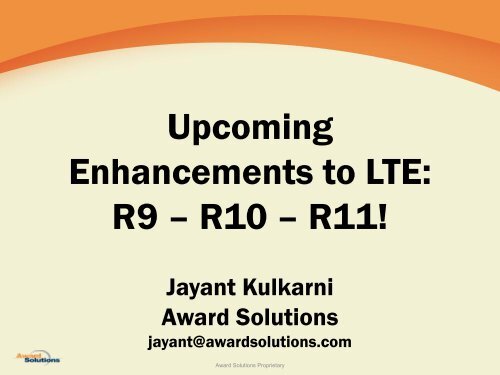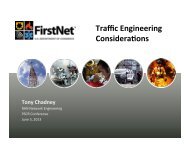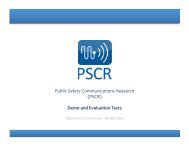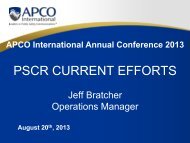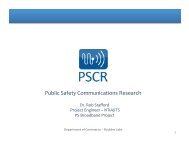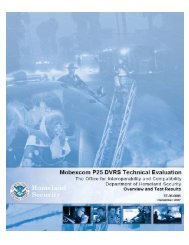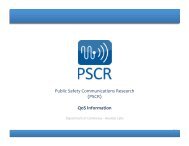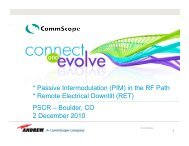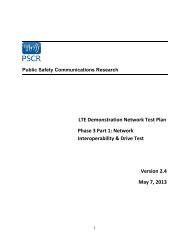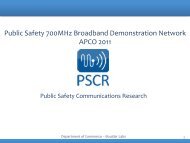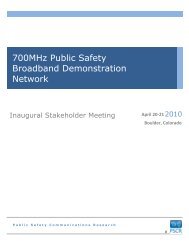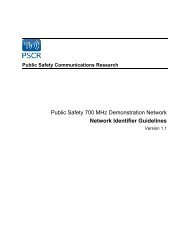Create successful ePaper yourself
Turn your PDF publications into a flip-book with our unique Google optimized e-Paper software.
Upcoming<br />
Enhancements to LTE:<br />
R9 – R10 – R11!<br />
Jayant <strong>Kulkarni</strong><br />
Award Solutions<br />
jayant@awardsolutions.com<br />
Award Solutions Proprietary
Award Solutions<br />
• Dallas-based wireless training and consulting<br />
company<br />
– Privately held company founded in 1997<br />
• Deliver nationwide training programs for most major<br />
operators in North America<br />
– LTE, UMTS-HSPA, EVDO, IP, Ethernet, MPLS, IMS, …<br />
• Often provide consulting help to operators when<br />
rolling out new technologies<br />
– Writing technical sections of RFPs, comparing RFP<br />
responses, defining KPIs, acceptance test plans, etc.<br />
• Vendor-agnostic, unbiased provider of technical<br />
expertise<br />
Award Solutions Proprietary
Evolution to 4G Standards<br />
UMTS<br />
(R99)<br />
HSPA<br />
(R7)<br />
LTE<br />
(R8)<br />
LTE-<br />
Advanced<br />
(R10)<br />
GSM<br />
“2G”<br />
IMT-<br />
2000<br />
IMT-<br />
Advanced<br />
“3G”<br />
“4G”<br />
IS-95<br />
cdma<br />
2000<br />
(1x)<br />
1xEV-<br />
DO<br />
Award Solutions Proprietary
R 99<br />
3GPP Evolution: Toward LTE-Advanced<br />
Release 99<br />
Voice, 2 Mbps (384<br />
kbps) data rate<br />
Release 4<br />
Bearer-independent<br />
CS architecture<br />
R 4<br />
Release 6<br />
HSUPA (5.76 Mbps UL)<br />
R 5<br />
R 6<br />
R 7<br />
Release 5<br />
HSDPA (14 Mbps DL)<br />
Award Solutions Proprietary<br />
Release 10<br />
LTE-Advanced (3 Gbps DL<br />
and 1.5 Gbps UL)<br />
Release 8<br />
LTE (300 and<br />
75 Mbps)<br />
R 8 R 9<br />
Release 7<br />
HSPA+ (21/28 Mbps)<br />
Release 11<br />
HetNet, CoMP<br />
R 10<br />
R 11<br />
Release 9<br />
LCS, VoLTE, CMAS,<br />
eMBMS, Emergency<br />
calls using IMS
Voice Options for LTE<br />
How do we support Voice Calls?<br />
Circuit-Switched Fallback<br />
• Circuit-Switched call<br />
• At call setup, push over<br />
to CS domain<br />
• IMS is not required<br />
Single-Radio Voice Call Continuity<br />
• VoIP call<br />
• Handover from VoIP in LTE to<br />
Circuit Switched (UMTS/1x)<br />
• IMS Based<br />
Voice over LTE (VoLTE)<br />
• VoIP in LTE using IMS<br />
• SMS over IP using IMS<br />
• Industry-wide initiative<br />
Circuit Core<br />
IMS<br />
IMS<br />
Award Solutions Proprietary
VoLTE: What and Why<br />
Goals: 1. Simplify<br />
2. Common VoIP Solution<br />
Basic IMS:<br />
Too many features<br />
(not all needed in<br />
deployment)<br />
IMS Too Flexible:<br />
Multiple ways of<br />
doing same task<br />
(e.g., authentication)<br />
Areas of Focus<br />
Basic Functions<br />
and Supplementary<br />
Services<br />
(Ex: IMS-AKA for<br />
authentication)<br />
Media<br />
Characteristics<br />
(Ex: AMR Codec)<br />
Award Solutions Proprietary<br />
EPS<br />
Capabilities<br />
(Ex: RoHC)<br />
Common<br />
Functions<br />
(Ex: IPv4 and<br />
IPv6 support)
Media for VoLTE<br />
Bandwidth efficient and<br />
octet aligned formats<br />
for AMR payload<br />
RTCP unused except<br />
during media hold<br />
All eight AMR modes<br />
and source rate<br />
controlled operation<br />
Voice<br />
Requirements<br />
Use of RTP/UDP with<br />
same port number for<br />
sending and receiving<br />
RTP packets<br />
Use of RoHC<br />
Use RTP Profile AVP<br />
and one speech<br />
frame per RTP<br />
packet<br />
SDP capability<br />
negotiation frame<br />
work not used<br />
Award Solutions Proprietary
Delivering Services (e.g. voice) Using IMS<br />
AS<br />
SCS<br />
AS<br />
Sh<br />
ISC<br />
HSS<br />
PCRF<br />
Cx<br />
CSCF<br />
Signaling<br />
Traffic<br />
S-GW<br />
P-GW<br />
P-GW<br />
S-GW<br />
Award Solutions Proprietary
Location Services (LCS)<br />
Types of Services<br />
• Value Added Services<br />
How do you determine Location?<br />
• Assisted GPS (A-GPS)<br />
• Emergency Services<br />
• PLMN Operator Services<br />
• Observed Time Difference<br />
of Arrival (OTDOA)<br />
• Enhanced Cell ID (E-CID)<br />
• Lawful Intercept<br />
Award Solutions Proprietary
Assisted GPS (A-GPS) Method<br />
Delay t 1<br />
t 2<br />
t 3<br />
t 4<br />
UE<br />
Assistance<br />
Data<br />
E-SMLC<br />
Three satellites needed for 2D position, four for 3D<br />
Award Solutions Proprietary
OTDOA<br />
PRS<br />
Arrival time<br />
measurement<br />
PRS<br />
PRS<br />
E-SMLC<br />
OTDOA: Observed Time Difference Of Arrival<br />
PRS: Positioning Reference Signals<br />
At least 3 cells needed to position the UE<br />
Award Solutions Proprietary
E-CID – AoA and RSRP Map<br />
1. Angle of Arrival (AoA) enhancement<br />
• eNB estimates the direction UE signals come from<br />
• Builds on RTT measurements<br />
Basic Cell ID Cell ID + RTT Cell ID + RTT +AoA<br />
2. RSRP Map enhancement<br />
• Matches the UE’s signal strength to<br />
location<br />
Award Solutions Proprietary
Multicast Broadcast in LTE<br />
Broadcasting of<br />
messages/packe<br />
ts + Streaming<br />
Applications<br />
The option of<br />
“Multicasting”<br />
data to multiple<br />
eNBs<br />
Sending data<br />
only once over<br />
the air<br />
Parameters<br />
Values<br />
Bandwidth (MHz) 1.4, 3, 5, 10, 15, 20<br />
Subframe duration<br />
1 ms<br />
OFDM symbols per slot Only 6<br />
Modulation schemes<br />
MIMO scheme<br />
QPSK, 16QAM, 64QAM<br />
Only a single antenna<br />
Award Solutions Proprietary
What’s New with eMBMS?<br />
Updated for eMBMS<br />
(identifies eMBMS<br />
subframes)<br />
Location of the<br />
eMBMS channels<br />
eMBMS Data<br />
Award Solutions Proprietary
Requirements of IMT-Advanced<br />
Very High Data Rates<br />
(1 Gbps for low mobility,<br />
100 Mbps for high mobility)<br />
Interworking and<br />
Global Roaming<br />
200 300<br />
100<br />
400<br />
500<br />
0<br />
Enhanced Capacity<br />
(~40 VoIP users per sector/MHz)<br />
Wider Spectrum<br />
(Up to 40 or 100<br />
MHz)<br />
High Spectral Efficiency<br />
(Peak: 15 or 6.75 bits/s/Hz)<br />
Mobility up to 350<br />
km/hr<br />
Low Latency<br />
U-plane: < 10 ms<br />
C-plane: < 100 ms<br />
Handover Interruption<br />
(27.5 or 40 ms)<br />
Award Solutions Proprietary
LTE-Advanced Targets<br />
Mobility<br />
Up to 350 or 500 Kmph<br />
High Data Rates<br />
DL: 3 Gbps,<br />
UL: 1.5 Gbps<br />
Low Cost<br />
• Deployment cost of<br />
infrastructure and UE cost<br />
• Power efficiency<br />
• LTE-based backhaul<br />
• SON optimization<br />
Low Latency<br />
< 50 ms (Idle Connected),<br />
< 10 ms (Dormant to Active in<br />
Connected)<br />
New Spectrum Support<br />
Examples:<br />
• 450 to 470 MHz band<br />
• 3.4 to 4.2 GHz band<br />
Spectral Efficiency<br />
DL: 30 bits/sec/Hz<br />
UL: 15 bits/sec/Hz<br />
Underlined Items:<br />
Better than IMT-<br />
Advanced<br />
Award Solutions Proprietary
Key Features of LTE-Advanced<br />
Tx<br />
Rx<br />
Enhanced Multiple-<br />
Antenna Techniques<br />
• (8x8) DL SU-MIMO<br />
• Enhanced DL Beamforming<br />
• (4x4) UL SU-MIMO<br />
Coordinated Multi-Point<br />
Transmission/Reception<br />
eNB<br />
Relay<br />
Relays<br />
UE<br />
20 20 20 20 20<br />
100MHz<br />
Carrier Aggregation<br />
Latency Reduction<br />
Award Solutions Proprietary
R11: Heterogeneous Networks<br />
Macro-cells<br />
Home eNodeB<br />
Pico-cells<br />
Enhanced<br />
Inter-Cell<br />
Interference<br />
Coordination<br />
Relays<br />
Femto-cells<br />
Award Solutions Proprietary
Conclusions<br />
• LTE is here!<br />
• LTE (R8) is just the beginning – prepare for a<br />
slew of upgrades<br />
• VoLTE is a big step for the cellular industry –<br />
most rely on existing (3G) voice infrastructure at<br />
the outset<br />
• LTE-Advanced (R10) is “true” 4G - it introduces<br />
a number of exciting features<br />
• Heterogeneous networks are being deployed,<br />
but managing interference is a key challenge<br />
Award Solutions Proprietary


